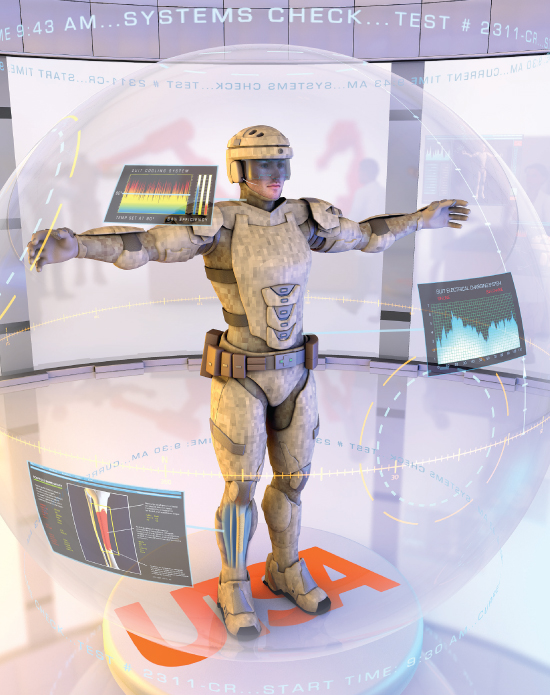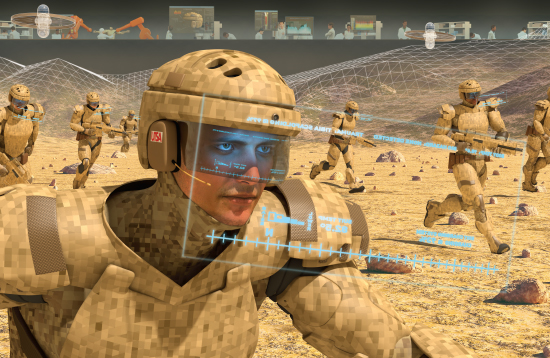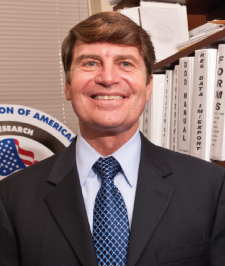UTSA Builds Military Connections
Improving the tools and readiness of the nation’s military might

American soldiers who go to war rely on the best and brightest minds back home to help keep them safe and effective during their dangerous missions. The Department of Defense and each branch of the armed forces pour millions of dollars every year into research and development efforts at universities and private companies around the nation. There, scientists and engineers continuously strive to implement the latest knowledge and newest technology to improve everything a soldier uses, from aircraft and tanks to weapons and computers and uniforms. In biomedical fields, the military is at the forefront of research projects to develop new medications, protective vaccinations and wound care—work that simultaneously supports improved civilian health care. In the training venue, military leaders and university scholars take contemporary knowledge about leadership skills and human psychology into the classroom and training fields to prepare the next generation of officers and recruits. In mental health, there is a growing awareness that soldiers who deploy to the battlefield, and their family members who stay home, face unique life challenges that can benefit from the help of trained psychologists. Increasingly, the American armed forces are finding that The University of Texas at San Antonio (UTSA) is a capable partner in this ongoing task of improving the tools and the readiness of the nation’s military might. Research collaborations are the cornerstone of this thriving relationship. UTSA has also built programs around military needs, including an undergraduate minor in military leadership and a psychology doctorate that focuses on the special needs of soldiers and their families. Thriving ROTC programs also work to prepare the next generation of military officers. “Over the last five to seven years, our working relationship with the military really has grown,” said Jim Massaro, a retired Air Force colonel who now is UTSA’s assistant vice president for research security and military liaison between the University and the various military branches. “We are building more collaboration between the military and other San Antonio institutions to work on projects in medicine, engineering and cyber security.”

The University’s location is a contributing factor. Air Force and Army installations have long been part of the fabric of life in San Antonio. The most recent federal base realignments consolidated military medical training at Fort Sam Houston, a strategic move that now brings even more active duty military personnel to the Alamo City. The city’s total military base population is now 78,000 people, 10,000 more than a few years ago, Massaro said. These growing ties between UTSA and the military rely heavily on the University’s expanding research capabilities. As UTSA recruits top faculty members in biological, engineering and computer sciences, the number of military grants and contracts continues to grow. “We’ve got tremendous faculty members. Many are world-renowned researchers, experts in their fields. They bring us top students, and they attract new research interests.” UTSA is also building bridges to connect with major companies that routinely seek government contracts. The University has a federal designation as a minority-serving educational and research institution. This attracts companies that need to meet federal goals for hiring subcontractors owned by minorities or using research institutions that serve minority students, Massaro said. Biomedical research has brought the biggest grants so far, due in part to the medical research and training programs at Fort Sam Houston. The proximity of this military mission makes collaborative studies efficient for both the military and regional research institutions. In addition, UTSA has access to regional collaborative partners, such as the University of Texas Health Science Center at San Antonio, which also has clinical and basic research initiatives with the military branches. One of the newest programs is a $4.6 million grant from the Department of Defense to support a Center of Excellence in Infection Genomics (CEIG), centered at UTSA but involving scientists from the health science center and other regional research institutions. The scientific strategy, said CEIG Director Bernard Arulanandam, Ph.D., Jane and Roland Blumberg Professorship in Biology, is to undermine potentially dangerous infective agents by learning about their most basic genetic structure and understanding how these genes interact with the genes of an infected human. “The whole idea is to study how the genes from the microorganism and the host interact. That merging of data will make better use of our knowledge and will lead to translational research on developing new therapies and vaccines.”
“We are building more collaboration between the military and other San Antonio institutions to work on projects in medicine, engineering and cyber security.”
American military troops deploy all over the world, routinely serving in remote and exotic locations where they may encounter endemic infections and emerging diseases that are not found at home. Soldiers also would be a prime target for potential battlefield enemies with biological weapons. Scientists are racing to learn about a wide range of diseases that can be transmitted naturally or through biological weapons. And because they deploy all over the world, American soldiers are an important part of the global influenza-monitoring system that determines which strains should be covered in the millions of vaccine doses manufactured and dispensed every year.
CEIG is an umbrella that will cover teams of researchers who will work together and share resources as they explore genomics of respiratory infections, cholera, tularemia, fungal infections and other vectors that can affect troops in the field as well as civilians at home, Dr. Arulanandam said. UTSA also is responding to the military’s interest in helping soldiers and their families with the stress of this lifestyle. Last February the Texas Higher Education Coordinating Board approved a doctoral degree in psychology that will focus on mental health issues relevant to military men and women and their families. Like other military-related research programs, the new program in the College of Liberal and Fine Arts will build on the collaborative efforts of researchers from military and civilian institutions in the San Antonio area. UTSA leaders expect the University to become one of the leading programs in the nation for investigating health and mental health care issues that relate to military personnel and their families.
Engineers and physicists also are involved in the development of potential biomedical tools. USAA Foundation Distinguished Professor and Chair of the UTSA Department of Biomedical Engineering Anson Ong, Ph.D., has a grant from the Army to develop synthetic scaffolding that can be used to help the body’s own repair mechanisms in rebuilding bone tissue damaged by battlefield wounds. Astronomy Department Chairman and Lutcher Brown Distinguished Chair Miguel José-Yacamán, Ph.D., has a grant from the Air Force to study interactions of cells with various nanoparticles. Mechanical and civil engineering faculty at UTSA also are working on large and small projects to improve military hardware. Drew Johnson, Ph.D., assistant professor of civil engineering, has an Air Force research grant to study heat transfer through nanofluids, technology that may lead to smaller and more efficient heating and cooling equipment for military gear. Chair of Mechanical Engineering and Zachary Mechanical Engineering Department Endowed Chair Harry Millwater, Ph.D., is an expert in fracture mechanics and is testing new methods of analyzing fatigue in various metals and other materials that are used in military equipment.
One of the more imaginative projects is by Arturo Ayon, Ph.D., associate professor of physics, who is testing whether body heat can be captured by specialized fabrics and converted into useable energy. “The average Army guy is carrying 66 pounds of equipment and batteries with him when he marches off into the desert,” Jim Massaro said. “The question at hand is whether there is a way to capture the heat his body is generating and turn it into a storable form of energy. Can he generate power just by walking and transmit it through his clothes into a storage device? UTSA is at the forefront of trying to figure out if this can be done.”
“The average Army guy is carrying 66 pounds of equipment and batteries with him when he marches off into the desert.”
Computer security is another vital area of work for national security. The UTSA Institute of Cyber Security, led by Lutcher Brown Distinguished Chair Ravi Sandhu, Ph.D., does research and development on ways to protect the vast amount of confidential data stored in computers everywhere, including the military. Shouhuai Xu, Ph.D., associate professor of computer science, has a contract with the Air Force to secure its computers from malware that can connect them to botnets, networks of computers that have been invaded and compromised so that they automatically forward information to other computers.
Most of these research programs are, by design, training grounds for master’s and doctoral level students, who then move on to become the next generation of experts in immunology, cyber security, mechanical and electrical engineering, and psychology. But UTSA also takes its mission with the military into the undergraduate and even high school levels through its computer competitions, ROTC programs and undergraduate degree coursework.
The core of this effort is through Reserve Officer Training Corps (ROTC) programs. Both the Army and Air Force operate regional ROTC programs that are headquartered at UTSA and draw students from UTSA and several other regional colleges and universities. ROTC students can earn academic scholarships to complete undergraduate or graduate degrees as they simultaneously train for appointments as military officers. The University’s ROTC detachments have grown in size and prestige in recent years. In 2009 the Air Force Detachment 842 at UTSA won the Right of Line Award, the most prestigious recognition presented each year by the Air Force. UTSA also recently added a study program that allows Army military trainees to earn a minor in Military Management and Leadership. This 21-course-hour program introduces students to principles of military leadership and offers courses on the historical, political, social and geographical context of global regions where officers may be deployed to lead soldiers in their military missions.
High school students have opportunities to learn about military missions through Cyber Patriot, a national competition in computer security that the Institute of Cyber Security hosts each year. It has grown into the world’s largest high school cyber security competition. Each April the institute also hosts the National Collegiate Cyber Defense Competition, which is the nation’s largest security-themed competition for college students.
The work continues for those on campus tasked with making sure business and community leaders know about UTSA and its expanding capabilities for developing new products and training young leaders. There is more to talk about each day, Massaro said.
“As we have continued in business development here, we have gone out and visited with these people and given them briefings on our capabilities, so whenever they need someone in these areas, we hope they will call on us.”
Error processing SSI file

